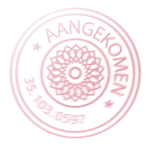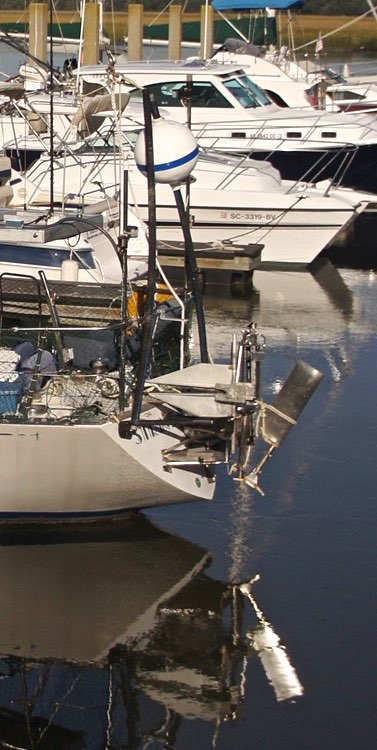
Coming up the mooring spot
To anchor, I lower the bridle until the ball float touches the water, then pay out the anchor rode over the roller at the stern until it fully deployed, usually 100 feet of 1/2 inch nylon for 12 feet of water, another 100 foot section is added for 20 feet of water. I can see the bottom to drop the anchor right below me onto a sand bar. Since the driver is standing next to me I can give quiet instructions to power ahead as I pay out the rode and until the strain comes on the bridle. Once the anchor begins to bury, I can relax, knowing that no matter which way the wind blows the pull will always be directly along the rode which buries the anchor more. All the time at anchor the wind pressure on the stern drags the anchor deeper.

Anchor Davits and stowage
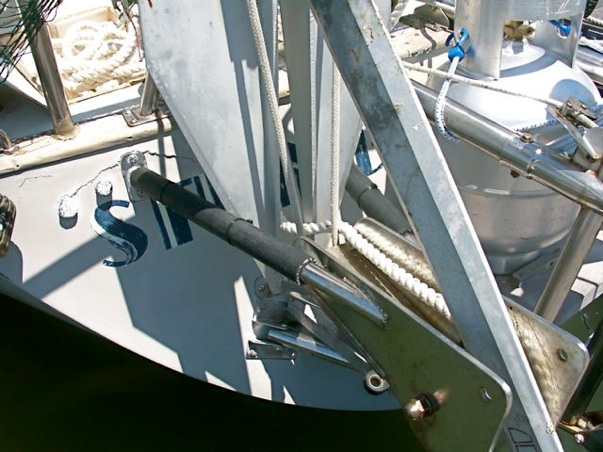
A sailboat naturally wants to sit with its stern to the wind because most of the windage o f the boat is the mast which is forward of the center of lateral resistance of the keel and hull. You can test your boat by letting it drift downwind with no sails up. It will usually drift stern to the wind. When you anchor off the bow the boat is continually trying to turn with its stern to the wind and that is why it yaws at anchor. This yawing pulls on the anchor which is turned this way and that and it can be pulled out. Also the rode chafes at the bow, and in a blow it can chafe through.
With stern anchoring there is no chafe. The pull is always from the same direction.
Movie showing boat yawing when bow anchored
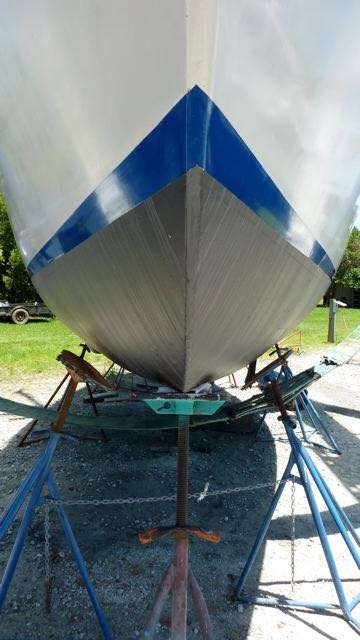
On the other hand the stern has a tremendous buoyancy and lifts to every wave, and the cockpit stays dry (unless it is raining hard.) It is easy to check the anchoring gear without leaving the cockpit.
Hurricane anchoring
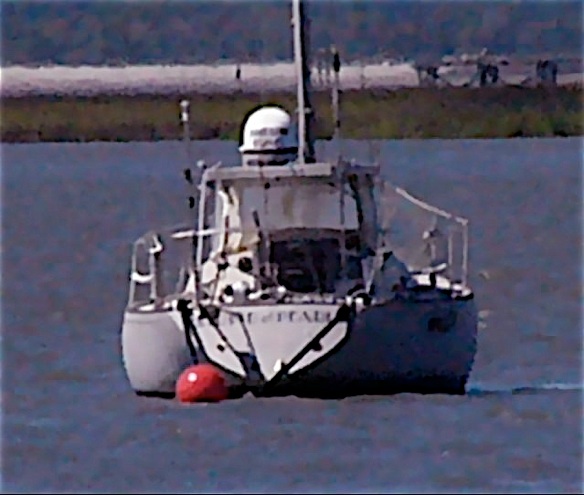
In Grenada I left it at anchor from the stern for three months while I went home. It was perfect when I got back.
Leaving the mooring
To leave the mooring we back up to the anchor by puling on the nylon rode, or by backing up with the engine until we are over the anchor. We haul it up (30 lbs), stow the anchor on its stern davit, draw up the bridle and attach it to the backstay, then hoist the jib and sail off the mooring. By the time we pull up the anchor the boat is already drifting slowly downwind pointed in the right direction.
Considering the boat design
Strange that most people don’t consider the anchoring system before buying a boat. You will spend ten times as much time at anchor as you do in the Ocean. You will worry more about anchoring than sailing. I have been hurricane anchored for four near misses, and never worried about the boat. I had to evacuate and go inland, so couldn’t watch the boat. Every time I returned, I found my boat safe and dry, while others were sunk, or blown onto the land. If you have watched the horrors of the aftermath of storms in the pond at St. Martin, in Grenada BWI, and Charleston after Hugo, you are bound to be fearful for your own boat.
If you can’t haul out the boat for a hurricane, you can anchor off the stern. But
You need to have a boat with place for anchor equipment, winch and davits off the stern. And one that has a counter not an open cockpit typical of charter boats.Not a flat stern that the waves will bang against.
You could set up the bridle on the stern and drop the anchor off the bow, and walk it around to allow the boat to hang of a stern anchor.
Don’t use chain rode. That should only be used for deep water over 100 feet, where the catenary provides some cushion from the shock load of waves hitting the boat. For shallow water you must build the elasticity into the system with nylon that stretches. In shallow water the chain will become bar taught in a blow and will jerk hard on the anchor and pull it out, or the links could snap. You need to use elastic anchoring where the nylon rode will stretch to absorb the shock of the wave and keep the shock load off the anchor. Never anchor in any place where there is coral or sharp rocks, and you won’t need chain for chafe protection. If you are in an area where the rode is likely to fray use just ten feet of chain at the anchor end.
Always anchor on firm sand to weather a storm. Soft mud is useless as a holding material. Hard clay is great for holding but very hard to get the anchor to bury because a sailboat has insufficient engine power to bury it.

If you are sailing to weather for a long period, the constant crashing of the waves into the bow will damage the bow roller and the deck fittings. On my boat the aluminum casting cracked, and the bow roller was bent when I was trying to escape hurricane Alma and had to go to weather for two days in heavy seas. Stow bow anchors below when at sea.

For my introductory PDF on stern anchoring click here SternAnchoring.pdf.


